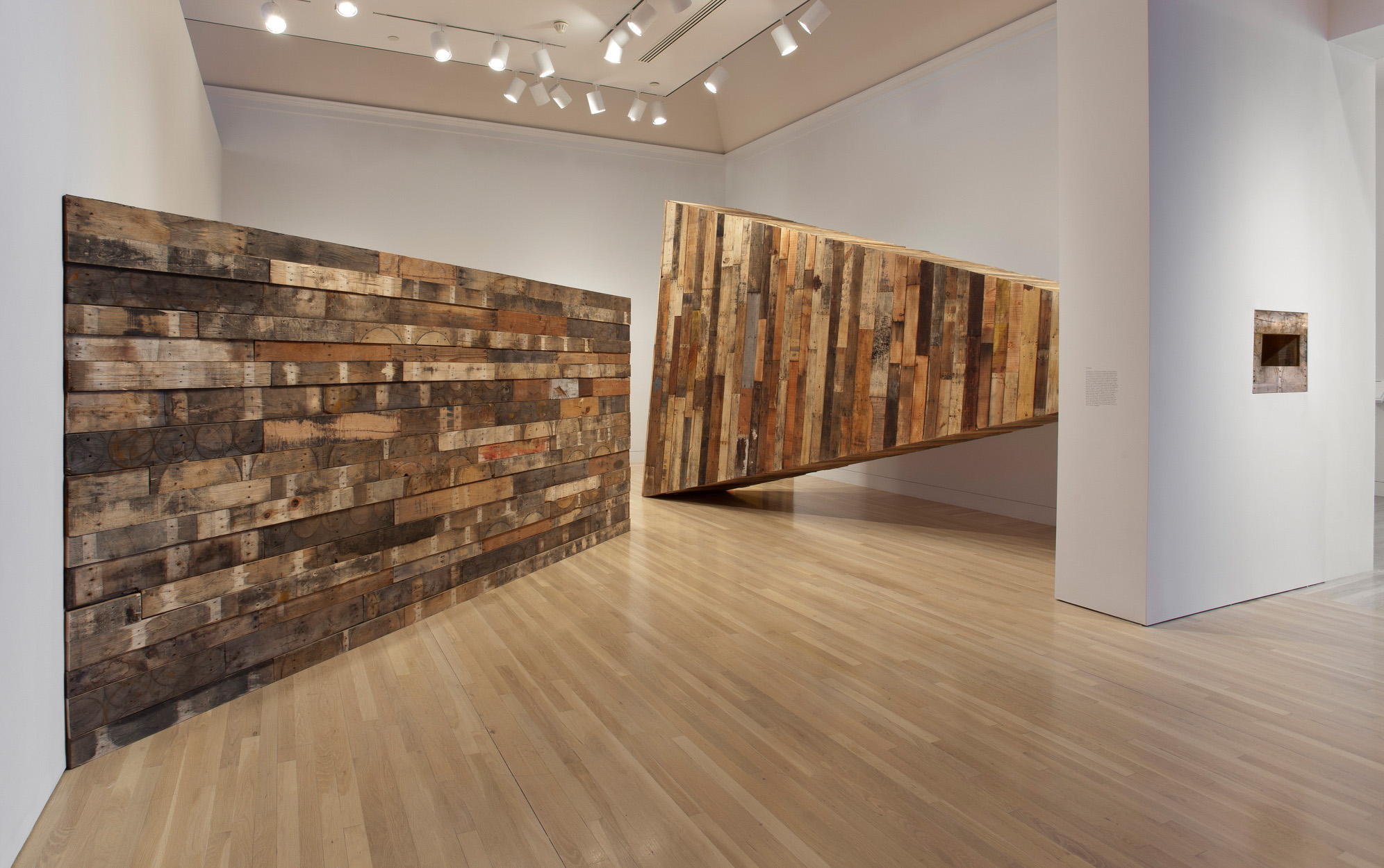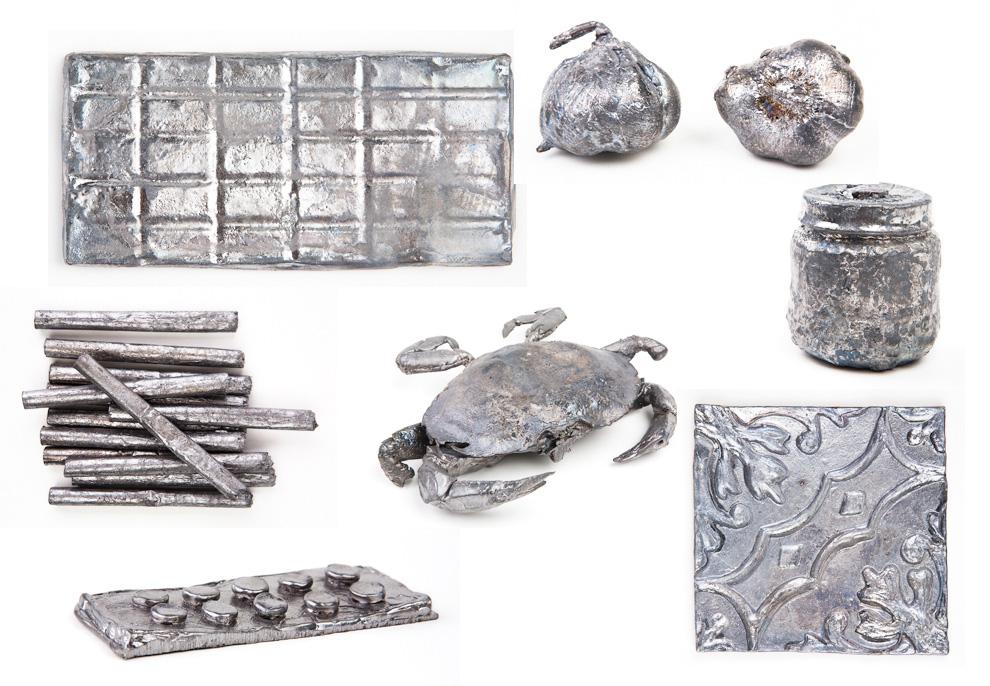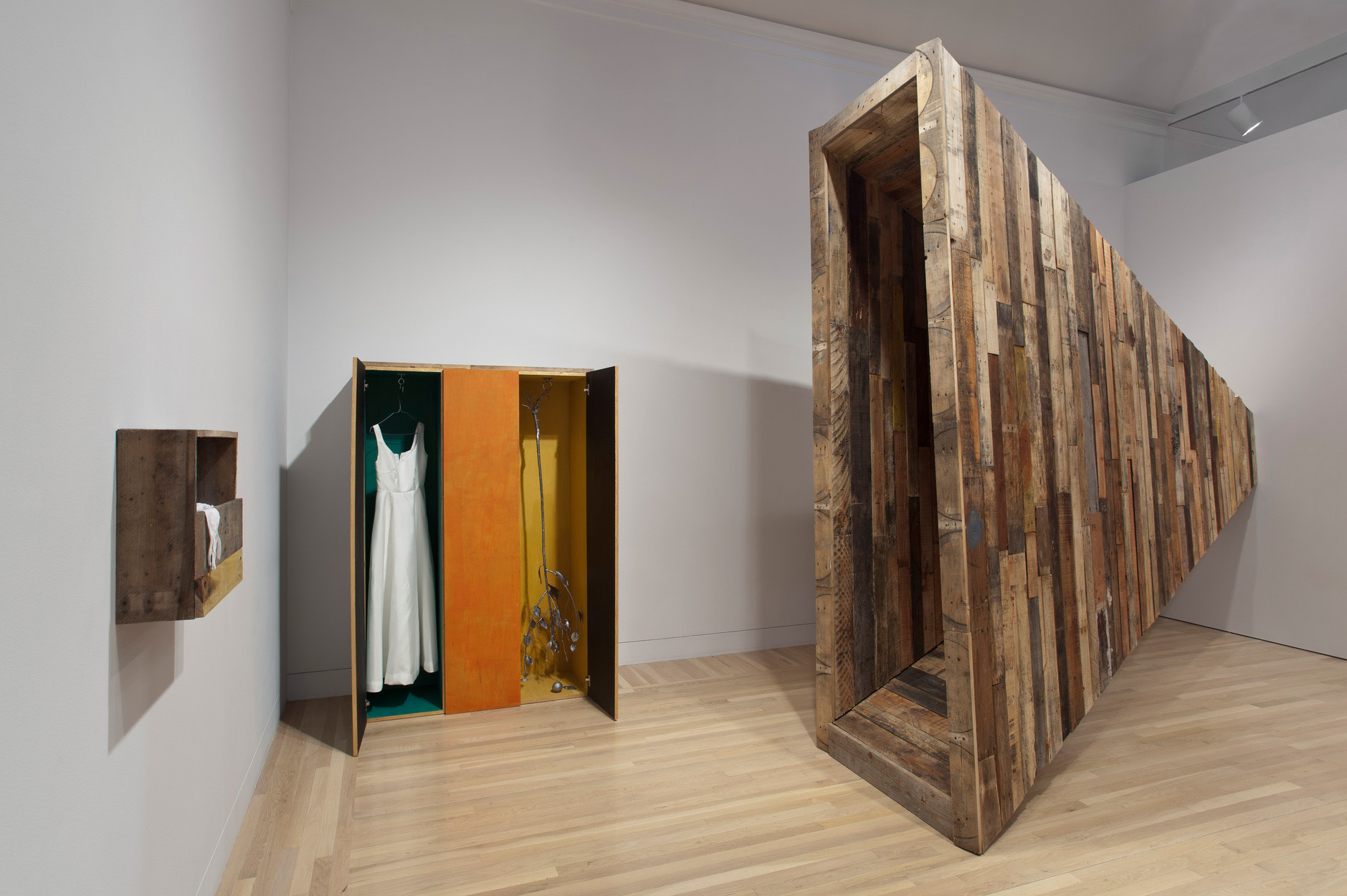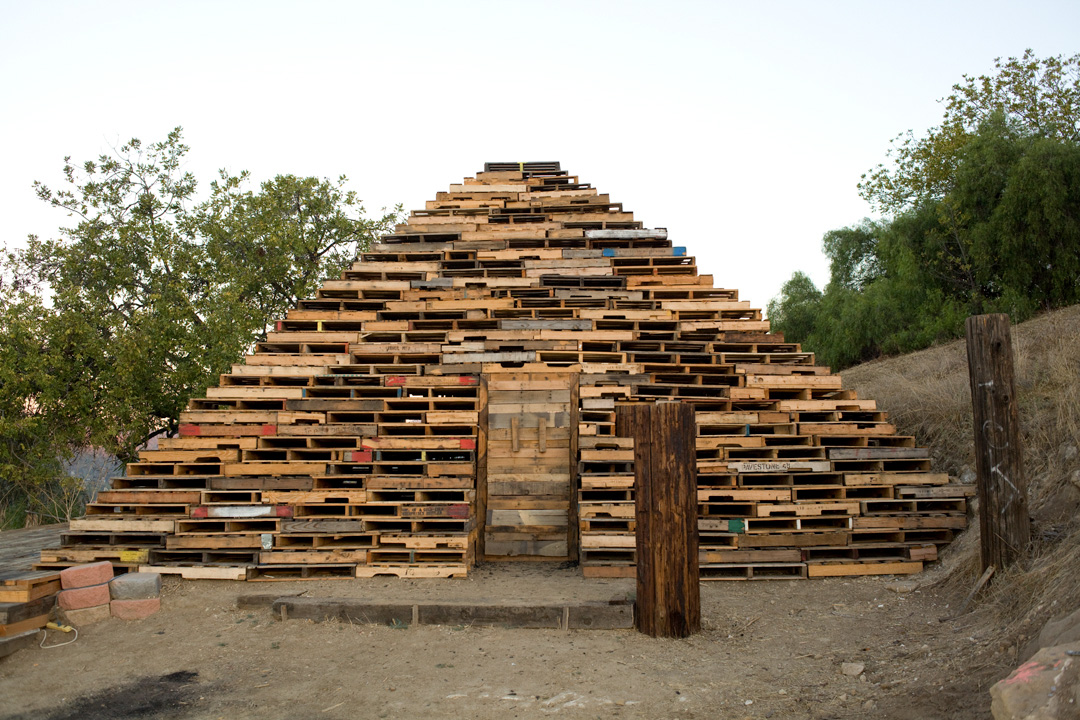Artists at Work: Liz Glynn
by Thomas Lawson

Liz Glynn, Made in L.A. 2012, 2012. Installation view at the Hammer Museum, Los Angeles. Photo: Brian Forrest. Courtesy of the Hammer Museum.
I met with Liz Glynn on July 17 in her Chinatown studio to discuss the work she created for the “Made in LA” 2012 biennial at the Hammer Museum this summer. The three-part installation—with multilayered references to Egyptian pyramids, smuggling tunnels into Gaza, and other spiritual and material trade routes, legitimate and not—continues an investigation of the intersection of antiquity and the present that began with her 2008 performance, The 24 Hour Roman Reconstruction Project, in which she invited people to help her build and then destroy a cardboard model of ancient Rome. Other related projects include the 2010 III, for which she built a pyramid of shipping pallets on a hilltop in East LA as the site of a series of performances, and the 2012 exhibit “No Second Troy,” which considers the parallel journeys of Trojan gold and Turkish workers to Germany.
THOMAS LAWSON: Let’s start by talking about the work at the Hammer. To me, there is something very compelling about the used pallets, the worn wood, the scuff marks, all the accumulated evidence of use and age placed against the clean white walls of the gallery. I don’t quite know what I want to say about this, but there’s something about the presence of that aged lumber in a museum context that seems very poignant somehow. It gives a kind of gravitas to the structure. Maybe it is that sense of overuse, of material that’s been worked to death in some way. You have used these shipping pallets before to great effect in the pyramid piece in East LA. Where did that come from?
LIZ GLYNN: The first time I used them I was interested in the pallets as this anonymous signifier of commerce. They’re used in trucking and shipping and used to carry a variety of different goods and often used for different commodities over time. They are also vigorously recycled: They get broken down; the parts get reused over and over. No single pallet shows any record of its own history, but collectively they bear the marks of a history of this movement across the country and even around the world. There are a lot of black marks that you’ll see on the wood, and they’re from forklift skids lifting the piece from underneath. I’ve been using the material as a signifier of anonymous movement, in a sense.
TL: Which is central to everything that you do.
LG: Yes, very much. I’ve been thinking about it in relation to work that I used to make when I lived in New England or in New York, where there’s a lot of building material that has this very precious surface quality to it, suggesting very specific histories. But there’s something about the interchangeable nature of the pallets. Each one has traveled in a specific direction; it feels to me more like the movement of people rather than the movement of one individual over time. So it’s this mass movement, which I like.
TL: The installation here consists of three pieces?
LG: Three pieces, yes. When you enter the space, it’s intentionally somewhat obfuscating. There’s a hole cut into one of the walls, this wooden framed space through which you peer into the first work, Passage (Giza / Gaza), which is a tunnel that creates a perspectival illusion of space opening up through the wall. When you come around the smaller museum wall, you see the side of the tunnel and across from it you see a large bank of similar material, which is the reclaimed forklift pallet slatting. But when you turn that corner, that bank of forklift pallet slatting is revealed to be a set of drawers, which are painted various colors. If you open the drawers, you find that they contain a variety of objects that are made of cast lead and ballistic fabric with resin. These objects are all copies of items that were reportedly smuggled under the border from Egypt into the Gaza Strip. This piece is called Anonymous Needs and Desires. Since the Battle of Gaza in 2007, when Hamas seized control of the Gaza Strip, there has been a proliferation of smuggling tunnels.

Liz Glynn, Anonymous Needs and Desires (Gaza / Giza), 2012. Detail. Cast lead, dimensions variable. Photo: Gaea Woods. Courtesy of Redling Fine Art, Los Angeles.
TL: And these objects range from garlic bulbs to jars of baby food to personal electronics like BlackBerries, right? I mean, it’s quite a range of—
LG: It’s a range from goods of necessity to goods of almost total fantasy. There’s a Dungeness crab somewhere in there. Tramadol was one of the most interesting objects: It’s a pain pill, and it’s maybe one of the most popular recreational drugs in the Gaza Strip. It has a mild numbing effect, and people who use it say it helps them deal with life in this tumultuous time. There’s also a lot of building material in the piece: copies of wooden studs and also metal studs, and sacks of cement. Some of these items were banned for their potential dual use, for bomb making as well as construction. But then there are also items that seem more romantic. In the far cabinet, there’s a wedding dress and a lemon tree that’s hung upside down. There’s one gentleman who told the story of having had a lemon tree brought in to put on his balcony so that he could be assured of having fruit through the year.
When ancient Egyptian artifacts are displayed in museums, one often sees bits of old food or some of these crates and things that were made of wood but just coated with enough layers of some sort of paint or something that they held up over time, also buried in the desert with no moisture to rot them. The idea of this sort of very fragile material enduring, I think, is really poignant in some way.
TL: So the material and the objects all speak in ways large and small about globalization and trade. How do you think of form here?
LG: Well, the forms also reference certain histories. For instance, the form of the large wooden tunnel called Passage is based on the architecture of the Grand Gallery inside the Great Pyramid, which is the tunnel that descends into the king’s chamber. There are a lot of historic etchings of this space, and I used these somewhat dated representations rather than photographs I might have taken when I actually visited the pyramids during my research. Despite picturing possibly fictive scenes from the colonial era, these etchings provide a good representation of the morphology of the interior forms.
TL: Right, and then that tunnel is about a royal tomb and then the other is about smugglers.
LG: What was interesting to discover is that the entry shafts of some of the tunnels between Egypt and the Gaza Strip are built out of very similar wood that’s used to cover the floors of the royal tombs to ease access for tourists. And so while the shape of these underground passages varies enormously, there is a similar feel to them materially.
TL: This play of similarity suggests big metaphorical readings—the pharaohs were buried with all the stuff they would need to survive in an afterlife; the Palestinians smuggle all these necessities underground in order to survive this life. You were talking the other night about the politics of the situation there: How do you see that playing out in the work? Or does it?
LG: What’s interesting to me is the fact that a lot of the objects smuggled in aren’t necessarily specific to the political conflict of that region. As I kept researching the tunnels, I became more and more interested in the fact that what’s actually smuggled over the border is less representative of the political imbalance there and more about simple human need. I think that people see the situation in the Gaza Strip, because of the religious history involved and the ramifications of that, as insolvable or completely intractable. So I think what the piece is trying to do in some way is to open up the idea that there’s something very ordinary and recognizable at the core of life in the Gaza Strip. With Anonymous Needs and Desires, the idea is, rather than think about it as a humanitarian crisis or political conflict, think about the lives of these people. Instead of thinking about the conflict as this inapproachable thing that we can’t touch, think about the situation as something that has implications that are more universal in terms of the human ability to deal with life.

Liz Glynn, Made in LA 2012, 2012. Installation view at the Hammer Museum, Los Angeles. Photo: Brian Forrest. Courtesy of the Hammer Museum.
TL: And that’s presumably where the open-ended performative aspect of the work comes in. Your public can come and move things around either in the space or throughout the museum, and in doing this potentially become empathetically engaged in the act of smuggling.
LG: Yes, part of the idea behind casting the objects in lead is that even though the objects are very small, they are incredibly heavy. Some of them are much more identifiable to us, and they are very pocketable—something like a BlackBerry or an iPod can just conveniently slip into your pocket. I’ve also specifically worked with the museum to position the security officer outside of the space so that you’re able to handle the objects behind the cabinets with no one watching you.
TL: So you’re setting up a temptation. Or an opportunity.
LG: Yeah, the opportunity, I think. But also, I’m someone who is hyperaware of having a guard at your back. I’m always the person who, in spite of knowing how close I can get, always leans too close to the sculpture.
TL: Using lead, as you said, gives these objects a weight that they wouldn’t have in real life. But lead is a base metal; it carries within it a sense of transformation?
LG: It does. It’s one of the alchemical bases for making gold. Another reason I chose to use the lead was that the Israeli military operation that occurred prior to the border controls becoming much tighter was known as Operation Cast Lead, as in bullets, which seemed kind of chilling.
But for experiential reasons, I am interested in the weight of these objects in your pockets. I really like the idea that this weight gives you a heightened awareness of these small things as you’re moving through the museum and that this might signify kind of an emotional weight to them.
Lead wasn’t a material that I’d worked with before, but when we first did them there are the unexpected qualities that emerge, like that lead is really malleable and so just hammering it will yield a mark and you can almost stick a fingernail into the pieces and leave a mark on them.
TL: Which means you can quickly get to that feeling of used-ness that you get on the pallets, I guess?
LG: The pieces are clear-coated, but over time the metal will oxidize and it will turn black, so they have to be recoated or polished up. I like that it doesn’t feel like a stable metal, that it feels like something that’s constantly being used and sort of alive in some way.
TL: You’re from the East Coast, but now you’re based here in Los Angeles. How come you’re doing so much research in the eastern Mediterranean area?
LG: It’s always been a way to talk about both emotional and political ideas that I’m interested in. At CalArts, when I tried to make work based on references that were a lot more contemporary, I found that people had already made up their minds, and it was harder for them to enter the work.
TL: Give me an example.
LG: I was trying to make a series of sculptures that had something to do with Buckminster Fuller, and instantly people would say, “Utopia failed.” I wanted to address something about possibility or human agency, but that was immediately short-circuited. So that was when I started developing the 24 Hour Roman Reconstruction Project, as a less direct way to talk about these things. The truism that Rome wasn’t built in a day had been used politically as an excuse for why Iraq could not be fixed or New Orleans rebuilt after Hurricane Katrina. I was interested in a physical, performative refutation of this, looking in a more historical sense at empires rising and falling and thinking of it as a metaphor for the American situation.
I visited Egypt in June 2011, so six months after the revolution happened, and the younger people that I met just walking around were all incredibly excited. Many of them used the analogy that the time of the great pyramids and the pharaohs was the last great moment in Egyptian history and that now we’ve hit the second. Whether it proves to be that significant, I think, is much more complicated than that. But that idea of approaching the moment with that sense of history really struck home to me.
In the great pyramids, there’s this very elaborate physical architecture that is actually a representation for the idea of the afterlife. And the way this metaphor was negotiated in real time was through the elaborate rituals laid out in the Book of the Dead. These rituals allowed the deceased to enter the eternal land and live there, with different chapters describing different destinations and the interactions necessary and expected.
So in III, the first pyramid piece that I did [in 2010], the idea was to borrow themes from the Book of the Dead to talk about the kind of uncertainty and superstition that maybe framed our thinking in the context of the financial crisis. I was specifically thinking about myself and a lot of the other artists I know, using all these kinds of puddle-jumping ways of dealing with our own financial situations or our own uncertainty about what we’re doing in the world—that whole, “if I pay this bill and not that one this month, if I do this and hope that that show works out” scenario. From this kind of trying to get through to the other side, it doesn’t seem like much of a leap to the anonymous transgression of smuggling, whether it’s trying to get through to the place where you’re safer or getting through this good that will improve the quality of your life.

Liz Glynn, III, 2010. Reclaimed wooden pallets, 16 x 27 x 27′. Courtesy of the artist and Redling Fine Art, Los Angeles.
At some point, I realized I was drawing pictures of myself sleeping in the back of a car, thinking about squeezing through things, or about different points in people’s lives that had become uncomfortable. So in the work, something like the specific situation on the border between the Sinai Desert and Gaza Strip becomes a stand-in for other ideas of passage, transgression, and anonymous movement. There is definitely a way that I think some of the themes are much larger and more archetypal. When I was making the drawings for the piece, I ended up just making all these drawings of tunnels over and over, thinking about the role of lightness and dark in painting, or how it functions architecturally inside the pyramids; lightness and dark, thinking about movement between life and death.
TL: You have talked about your travel and about making drawings as a way of thinking through the work. Can you talk a bit more about your process? I mean, you talk about developing your drawings; there’s the research; there’s the travel. How does it start and where does it—
LG: It usually starts with a passing reference in some other text I’ve been reading for another project. In this case, I’d done a series of smaller, really site-specific projects with nonprofits, and looking back at that work after a year, I was very unhappy with them. It felt like I was responding to very specific things but that I needed to figure out in a larger sense what I wanted the work to deal with in the world. At that time we were doing a class on cultural capital at The Public School, which got interesting only when people started talking about when they had gotten paid or not for museum shows, the precarious nature of their teaching jobs, and what their lives were actually like. I realized that conversations like that can be very difficult but generative and that I wanted to transpose that kind of information into an environment that wasn’t just discursive but was more emotional. I wanted to get at the emotions and anxieties, the real and valid responses to a situation that is usually dealt with objectively through journalism.
The fact that I had done III meant that the events in Tahrir Square resonated, and I began reading more about Egypt, going back historically but also reading news reports. Thanks to Google News, I was able to read investigative reports in papers ranging from the Christian Science Monitor to the Israeli daily Haaretz. And it was interesting because the politics of each site vary so widely: Some are highlighting drugs and guns, and others mention milk and baby food. In the case of the ancient Egyptian material, I looked at a lot of the British and American archaeologists who first excavated the great pyramids, photos from that period. I also got interested in the Egyptomania at the turn of the century, along with an interest in black magic and other strange undercurrents at the same time.
I spent several months doing this kind of research, and then I went to Egypt and tried to see as many things as I could firsthand. I emailed some of the English-speaking reporters who had reported on the smuggling tunnels, but no one was there at the time. I went to Cairo hoping that I could go and just experience walking around the street, but it was actually very difficult, as the cultural gap was a lot vaster than I anticipated. I’ve traveled a lot in Europe just by myself and walking around had never been an issue, but suddenly being an American woman in a Middle Eastern country was sort of like, “Oh, right, I’m not supposed to be doing this. I should be getting a car everywhere.” Which didn’t stop me from doing it for another week. I went and looked at all the pyramids, visited the Valley of the Kings, shot photos, made drawings, went to the Egyptian Museum. There, I actually cried within the first 30 minutes because it’s so sad. It’s completely overwhelming with the number and wealth of artifacts in comparison with the Met or anywhere else. And they’re all kept in, like, dusty cases, mostly without identification tags or labels. The King Tut room and the Ramses room were actually properly lit, but the rest of the museum is lined with cabinets full of jade beads or little amulets or whatever and no notification of what tomb they’re from. In part, the idea of these sets of drawers in the Hammer piece came from thinking a lot about a major national museum that foregrounds its storage in its main galleries so that you can apprehend the vastness of the collection, and so also of the history that represents.
I went to Egypt thinking there were two possible pieces for the Hammer. There was this one, or another piece that would have been called The Museum of 18 Days, which would have been all monumental sculptures based on ephemera documented during the protests and some of the artifacts from the Egyptian Museum that were damaged during that time. Because of the uncertainty around the future of the revolution, this project didn’t align with the gestalt that is a year of planning leading to a show.
Once I’d decided on the piece, I made a number of models and I quickly realized that I wanted the tunnel to penetrate the wall because it felt very important to implicate the institution and the museum, or the idea of a museum, in some way. I wanted to signal that the institution was somehow engaged. So I made a number of models and drawings, then over a couple months, in conversation with the preparators and the curators, figured out which wall it would be OK to cut into relative to the rest of the exhibition design, as other artists adjacent to me were shifting plans as well. We found a section of wall that could be penetrated, and I had the general proportions for the tunnel so we started building the tunnel. And one of the things that makes my life very difficult is that I can’t start making anything until I’ve let the research settle a lot and know what I am making and why. And then when I start making it there’s this whole other set of problems that arise. I spent about five months trying to find someone in LA who would cast lead, and there was no one; it turned out that I ended up mailing all the molds up to a company in the Bay Area. So I would get these flat-rate Priority Mail boxes back full of lead. It was the biggest abuse of the postal service. But that was how I ended up casting all of the objects. And coming to the final stretch, I decided to color-code the drawers, rather than face them with the forklift pallet slatting, which seemed inaccessible. I had wanted the drawers to be approachable but mysterious. I hesitated at first but decided to add a color-coding system so that the objects are originally placed in appropriate places—red for illicit substances, yellow is food, slate blue is technology, dark blue is building material, white is fuel. There might be one or two more. There’s one that’s clothing; I think it’s a turquoise.

Liz Glynn, Made in L.A. 2012, 2012. Installation view at the Hammer Museum, Los Angeles. Photo: Brian Forrest. Courtesy of the Hammer Museum.
TL: So when you were talking about resetting the installation from time to time that’s about putting the things back in the correct color-coded areas?
LG: Yeah, because the piece is interactive, people can move the small pieces around as they like, and what happens, as far as I can see from having gone in every couple weeks, is that if it gets arranged to a certain point people seem to stop rearranging it. So from time to time, I just return all the objects to the drawers they came in, leaving a couple of them out to encourage further movement. Some people seem to want to create narratives with the objects—the crab becomes a bit of a character, or the tiles will get arranged as though they’re actually tiles on the floor. They’re life casts of ceramic tile. I try the best I can not to exercise judgment in rearranging things—I don’t necessarily go in and make my own arrangement of the objects. I just return them to where they came from and count and see what has disappeared.